University Project Management: PROJ6006 Leadership and Team Dynamics
VerifiedAdded on 2022/09/18
|6
|1594
|25
Report
AI Summary
This report, focusing on PROJ6006, explores various leadership styles and their application in project management. It examines the selection of authoritative leadership, communication tools like Slack and Skype, scheduling software such as actiPLANS, and agile methodologies. The report details techniques for managing communication outside the project group, including project reports, presentations, and website updates. It also discusses the use of expert power to motivate team members and the methods for developing self-managed teams in agile projects. The rationale behind selecting these approaches, referencing module resources and real-world examples, is provided. Finally, the report outlines steps a project manager can take to mitigate challenges faced by the team, emphasizing the importance of communication, clear expectations, and risk analysis to ensure project success. The report references several academic articles to support the findings.
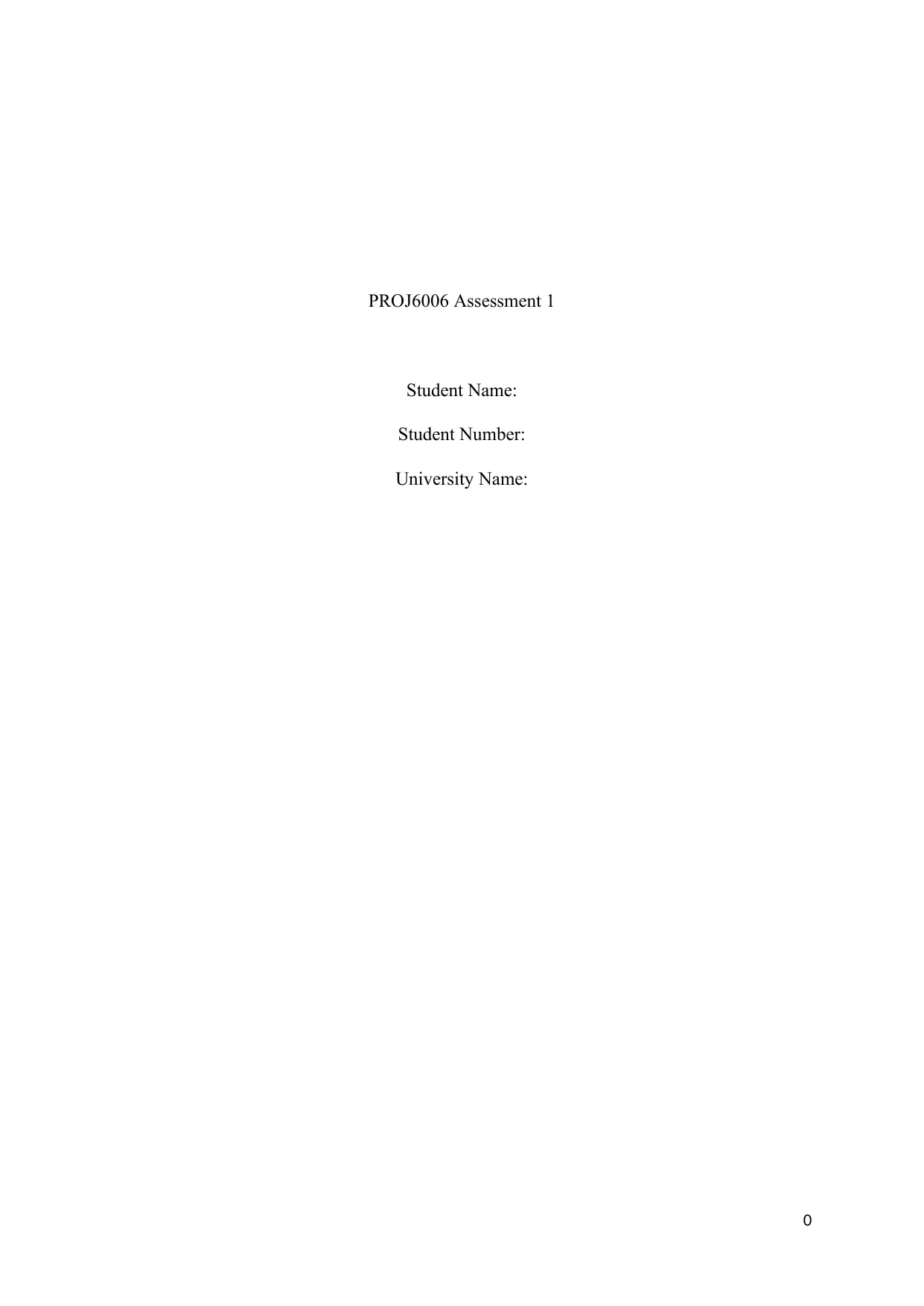
PROJ6006 Assessment 1
Student Name:
Student Number:
University Name:
0
Student Name:
Student Number:
University Name:
0
Paraphrase This Document
Need a fresh take? Get an instant paraphrase of this document with our AI Paraphraser
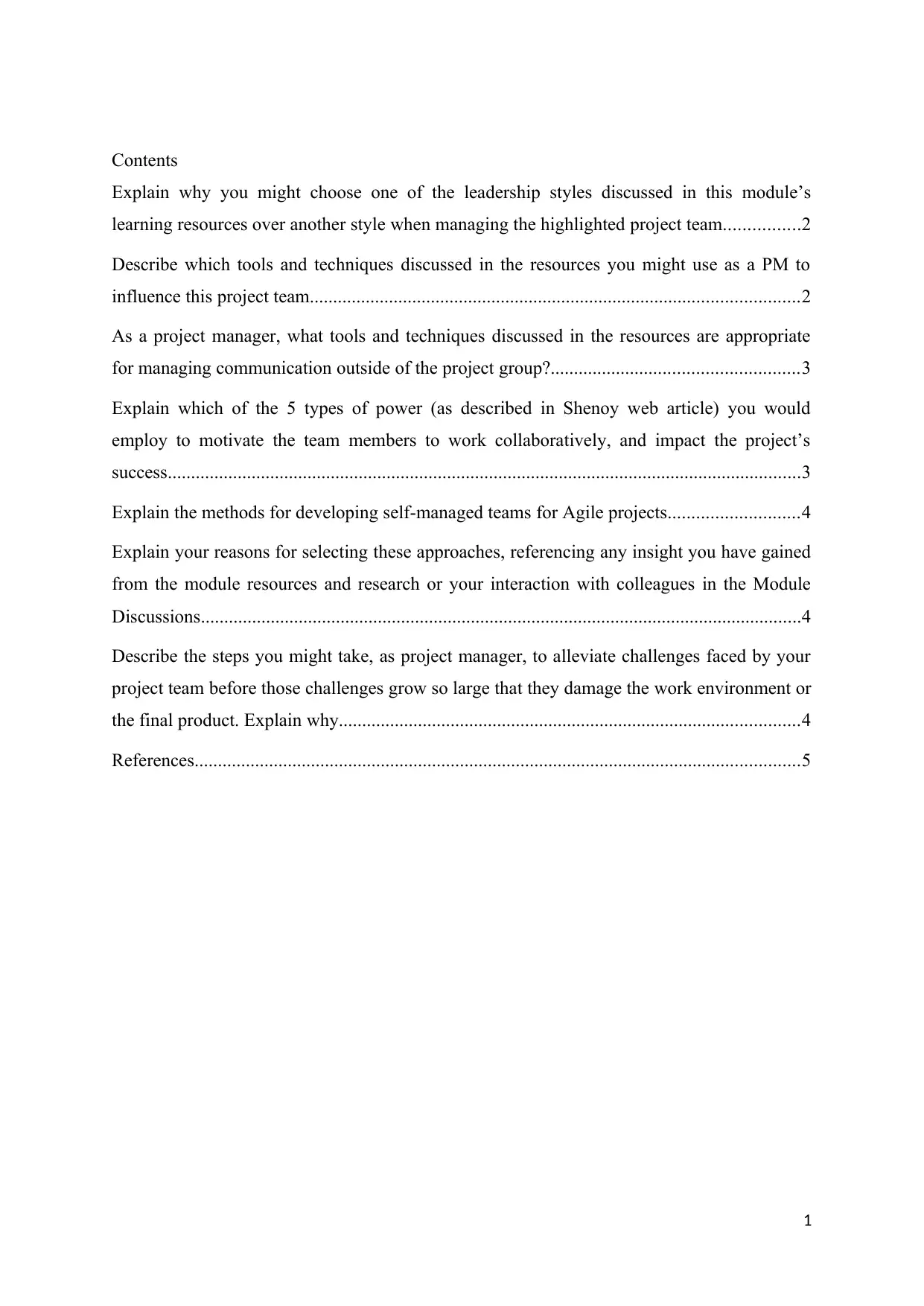
Contents
Explain why you might choose one of the leadership styles discussed in this module’s
learning resources over another style when managing the highlighted project team................2
Describe which tools and techniques discussed in the resources you might use as a PM to
influence this project team.........................................................................................................2
As a project manager, what tools and techniques discussed in the resources are appropriate
for managing communication outside of the project group?.....................................................3
Explain which of the 5 types of power (as described in Shenoy web article) you would
employ to motivate the team members to work collaboratively, and impact the project’s
success........................................................................................................................................3
Explain the methods for developing self-managed teams for Agile projects............................4
Explain your reasons for selecting these approaches, referencing any insight you have gained
from the module resources and research or your interaction with colleagues in the Module
Discussions.................................................................................................................................4
Describe the steps you might take, as project manager, to alleviate challenges faced by your
project team before those challenges grow so large that they damage the work environment or
the final product. Explain why...................................................................................................4
References..................................................................................................................................5
1
Explain why you might choose one of the leadership styles discussed in this module’s
learning resources over another style when managing the highlighted project team................2
Describe which tools and techniques discussed in the resources you might use as a PM to
influence this project team.........................................................................................................2
As a project manager, what tools and techniques discussed in the resources are appropriate
for managing communication outside of the project group?.....................................................3
Explain which of the 5 types of power (as described in Shenoy web article) you would
employ to motivate the team members to work collaboratively, and impact the project’s
success........................................................................................................................................3
Explain the methods for developing self-managed teams for Agile projects............................4
Explain your reasons for selecting these approaches, referencing any insight you have gained
from the module resources and research or your interaction with colleagues in the Module
Discussions.................................................................................................................................4
Describe the steps you might take, as project manager, to alleviate challenges faced by your
project team before those challenges grow so large that they damage the work environment or
the final product. Explain why...................................................................................................4
References..................................................................................................................................5
1
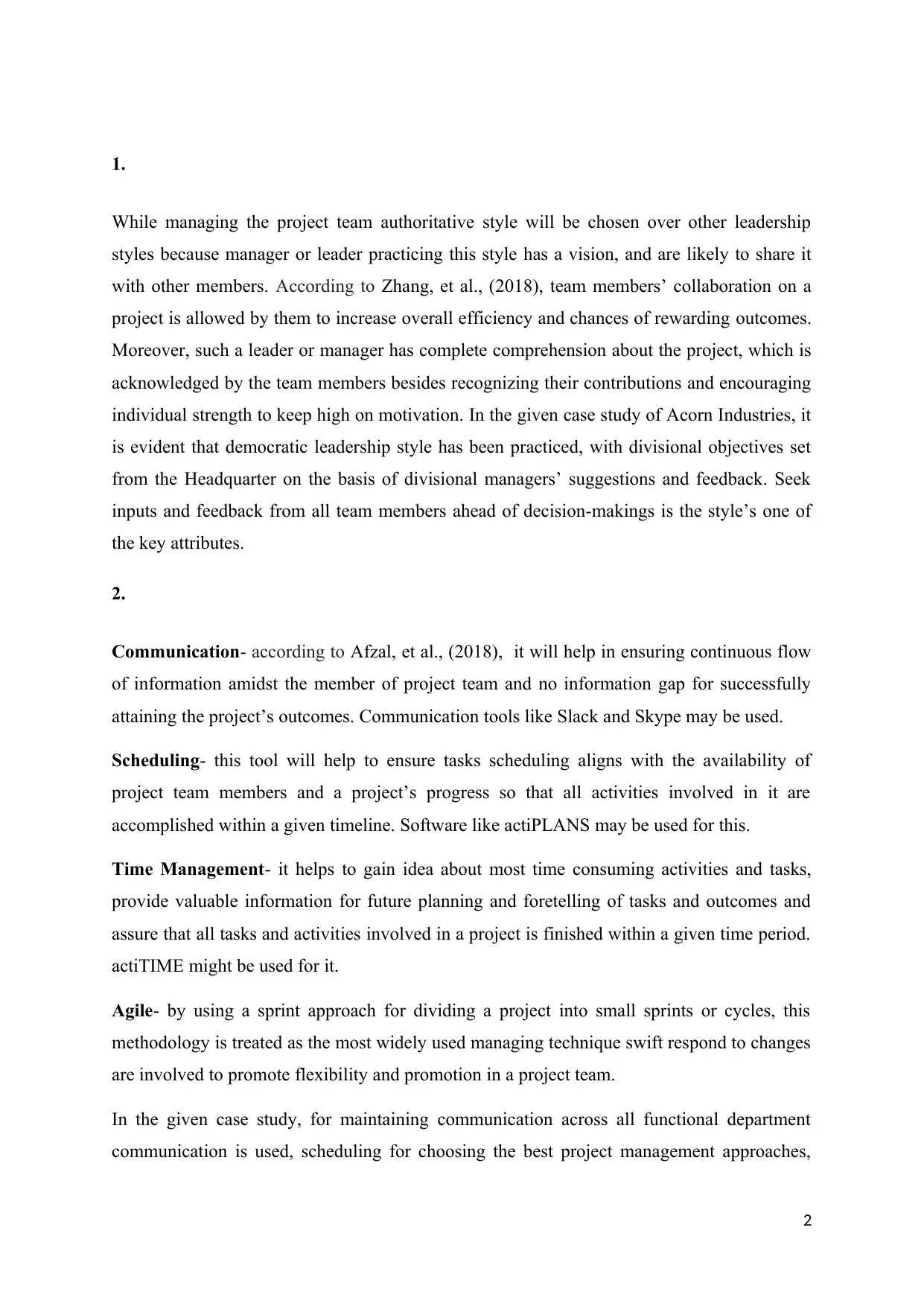
1.
While managing the project team authoritative style will be chosen over other leadership
styles because manager or leader practicing this style has a vision, and are likely to share it
with other members. According to Zhang, et al., (2018), team members’ collaboration on a
project is allowed by them to increase overall efficiency and chances of rewarding outcomes.
Moreover, such a leader or manager has complete comprehension about the project, which is
acknowledged by the team members besides recognizing their contributions and encouraging
individual strength to keep high on motivation. In the given case study of Acorn Industries, it
is evident that democratic leadership style has been practiced, with divisional objectives set
from the Headquarter on the basis of divisional managers’ suggestions and feedback. Seek
inputs and feedback from all team members ahead of decision-makings is the style’s one of
the key attributes.
2.
Communication- according to Afzal, et al., (2018), it will help in ensuring continuous flow
of information amidst the member of project team and no information gap for successfully
attaining the project’s outcomes. Communication tools like Slack and Skype may be used.
Scheduling- this tool will help to ensure tasks scheduling aligns with the availability of
project team members and a project’s progress so that all activities involved in it are
accomplished within a given timeline. Software like actiPLANS may be used for this.
Time Management- it helps to gain idea about most time consuming activities and tasks,
provide valuable information for future planning and foretelling of tasks and outcomes and
assure that all tasks and activities involved in a project is finished within a given time period.
actiTIME might be used for it.
Agile- by using a sprint approach for dividing a project into small sprints or cycles, this
methodology is treated as the most widely used managing technique swift respond to changes
are involved to promote flexibility and promotion in a project team.
In the given case study, for maintaining communication across all functional department
communication is used, scheduling for choosing the best project management approaches,
2
While managing the project team authoritative style will be chosen over other leadership
styles because manager or leader practicing this style has a vision, and are likely to share it
with other members. According to Zhang, et al., (2018), team members’ collaboration on a
project is allowed by them to increase overall efficiency and chances of rewarding outcomes.
Moreover, such a leader or manager has complete comprehension about the project, which is
acknowledged by the team members besides recognizing their contributions and encouraging
individual strength to keep high on motivation. In the given case study of Acorn Industries, it
is evident that democratic leadership style has been practiced, with divisional objectives set
from the Headquarter on the basis of divisional managers’ suggestions and feedback. Seek
inputs and feedback from all team members ahead of decision-makings is the style’s one of
the key attributes.
2.
Communication- according to Afzal, et al., (2018), it will help in ensuring continuous flow
of information amidst the member of project team and no information gap for successfully
attaining the project’s outcomes. Communication tools like Slack and Skype may be used.
Scheduling- this tool will help to ensure tasks scheduling aligns with the availability of
project team members and a project’s progress so that all activities involved in it are
accomplished within a given timeline. Software like actiPLANS may be used for this.
Time Management- it helps to gain idea about most time consuming activities and tasks,
provide valuable information for future planning and foretelling of tasks and outcomes and
assure that all tasks and activities involved in a project is finished within a given time period.
actiTIME might be used for it.
Agile- by using a sprint approach for dividing a project into small sprints or cycles, this
methodology is treated as the most widely used managing technique swift respond to changes
are involved to promote flexibility and promotion in a project team.
In the given case study, for maintaining communication across all functional department
communication is used, scheduling for choosing the best project management approaches,
2
⊘ This is a preview!⊘
Do you want full access?
Subscribe today to unlock all pages.

Trusted by 1+ million students worldwide
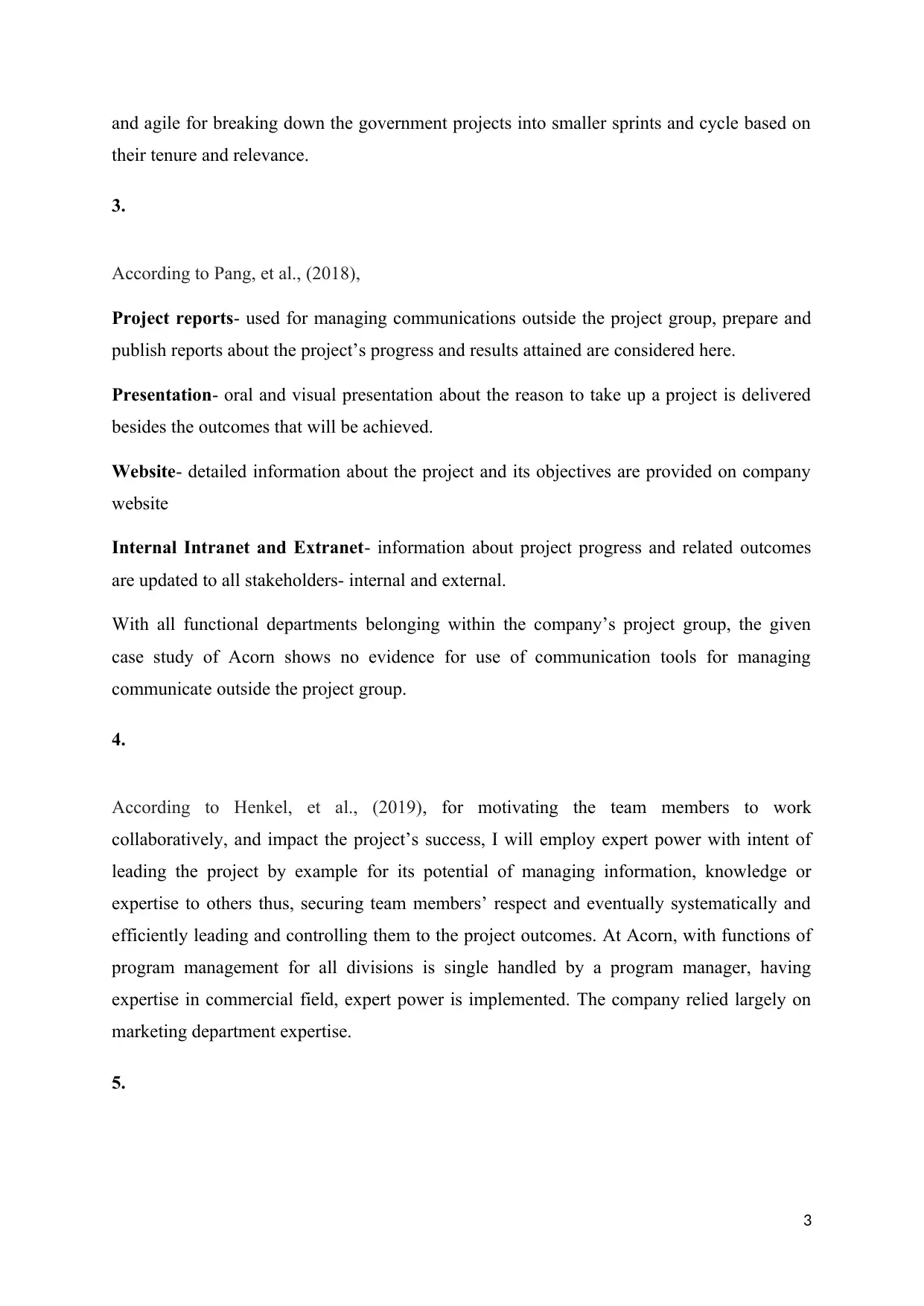
and agile for breaking down the government projects into smaller sprints and cycle based on
their tenure and relevance.
3.
According to Pang, et al., (2018),
Project reports- used for managing communications outside the project group, prepare and
publish reports about the project’s progress and results attained are considered here.
Presentation- oral and visual presentation about the reason to take up a project is delivered
besides the outcomes that will be achieved.
Website- detailed information about the project and its objectives are provided on company
website
Internal Intranet and Extranet- information about project progress and related outcomes
are updated to all stakeholders- internal and external.
With all functional departments belonging within the company’s project group, the given
case study of Acorn shows no evidence for use of communication tools for managing
communicate outside the project group.
4.
According to Henkel, et al., (2019), for motivating the team members to work
collaboratively, and impact the project’s success, I will employ expert power with intent of
leading the project by example for its potential of managing information, knowledge or
expertise to others thus, securing team members’ respect and eventually systematically and
efficiently leading and controlling them to the project outcomes. At Acorn, with functions of
program management for all divisions is single handled by a program manager, having
expertise in commercial field, expert power is implemented. The company relied largely on
marketing department expertise.
5.
3
their tenure and relevance.
3.
According to Pang, et al., (2018),
Project reports- used for managing communications outside the project group, prepare and
publish reports about the project’s progress and results attained are considered here.
Presentation- oral and visual presentation about the reason to take up a project is delivered
besides the outcomes that will be achieved.
Website- detailed information about the project and its objectives are provided on company
website
Internal Intranet and Extranet- information about project progress and related outcomes
are updated to all stakeholders- internal and external.
With all functional departments belonging within the company’s project group, the given
case study of Acorn shows no evidence for use of communication tools for managing
communicate outside the project group.
4.
According to Henkel, et al., (2019), for motivating the team members to work
collaboratively, and impact the project’s success, I will employ expert power with intent of
leading the project by example for its potential of managing information, knowledge or
expertise to others thus, securing team members’ respect and eventually systematically and
efficiently leading and controlling them to the project outcomes. At Acorn, with functions of
program management for all divisions is single handled by a program manager, having
expertise in commercial field, expert power is implemented. The company relied largely on
marketing department expertise.
5.
3
Paraphrase This Document
Need a fresh take? Get an instant paraphrase of this document with our AI Paraphraser
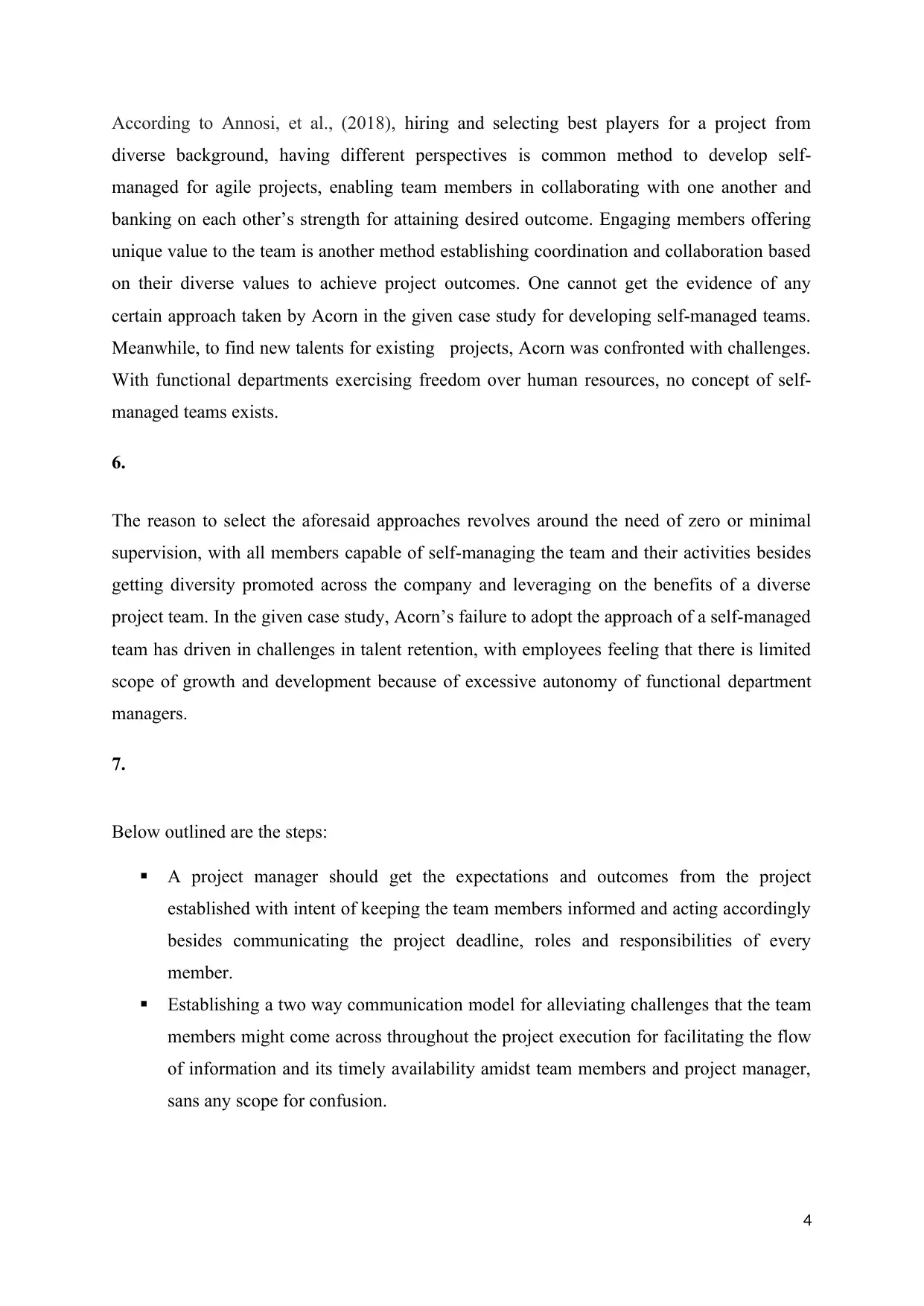
According to Annosi, et al., (2018), hiring and selecting best players for a project from
diverse background, having different perspectives is common method to develop self-
managed for agile projects, enabling team members in collaborating with one another and
banking on each other’s strength for attaining desired outcome. Engaging members offering
unique value to the team is another method establishing coordination and collaboration based
on their diverse values to achieve project outcomes. One cannot get the evidence of any
certain approach taken by Acorn in the given case study for developing self-managed teams.
Meanwhile, to find new talents for existing projects, Acorn was confronted with challenges.
With functional departments exercising freedom over human resources, no concept of self-
managed teams exists.
6.
The reason to select the aforesaid approaches revolves around the need of zero or minimal
supervision, with all members capable of self-managing the team and their activities besides
getting diversity promoted across the company and leveraging on the benefits of a diverse
project team. In the given case study, Acorn’s failure to adopt the approach of a self-managed
team has driven in challenges in talent retention, with employees feeling that there is limited
scope of growth and development because of excessive autonomy of functional department
managers.
7.
Below outlined are the steps:
A project manager should get the expectations and outcomes from the project
established with intent of keeping the team members informed and acting accordingly
besides communicating the project deadline, roles and responsibilities of every
member.
Establishing a two way communication model for alleviating challenges that the team
members might come across throughout the project execution for facilitating the flow
of information and its timely availability amidst team members and project manager,
sans any scope for confusion.
4
diverse background, having different perspectives is common method to develop self-
managed for agile projects, enabling team members in collaborating with one another and
banking on each other’s strength for attaining desired outcome. Engaging members offering
unique value to the team is another method establishing coordination and collaboration based
on their diverse values to achieve project outcomes. One cannot get the evidence of any
certain approach taken by Acorn in the given case study for developing self-managed teams.
Meanwhile, to find new talents for existing projects, Acorn was confronted with challenges.
With functional departments exercising freedom over human resources, no concept of self-
managed teams exists.
6.
The reason to select the aforesaid approaches revolves around the need of zero or minimal
supervision, with all members capable of self-managing the team and their activities besides
getting diversity promoted across the company and leveraging on the benefits of a diverse
project team. In the given case study, Acorn’s failure to adopt the approach of a self-managed
team has driven in challenges in talent retention, with employees feeling that there is limited
scope of growth and development because of excessive autonomy of functional department
managers.
7.
Below outlined are the steps:
A project manager should get the expectations and outcomes from the project
established with intent of keeping the team members informed and acting accordingly
besides communicating the project deadline, roles and responsibilities of every
member.
Establishing a two way communication model for alleviating challenges that the team
members might come across throughout the project execution for facilitating the flow
of information and its timely availability amidst team members and project manager,
sans any scope for confusion.
4
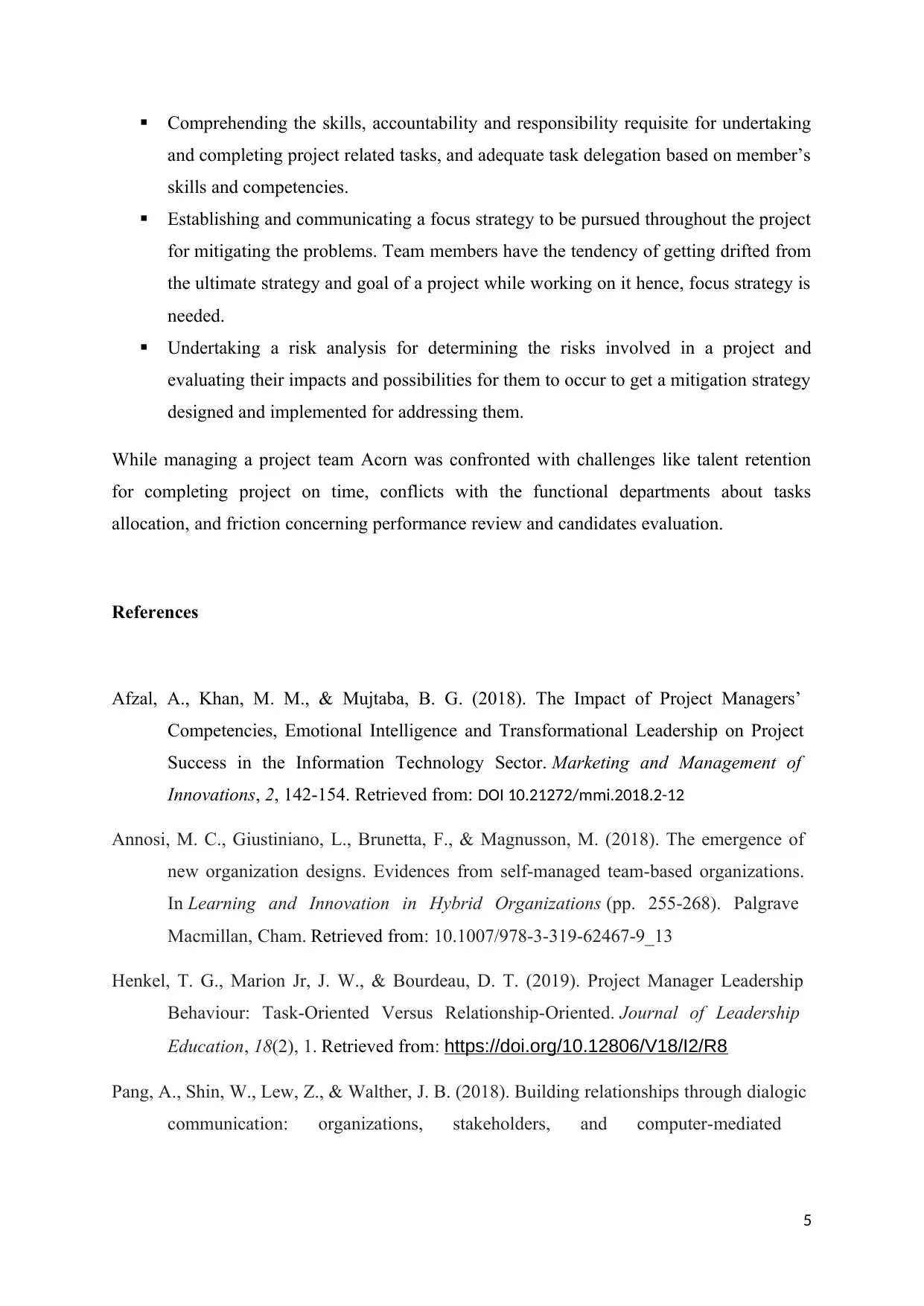
Comprehending the skills, accountability and responsibility requisite for undertaking
and completing project related tasks, and adequate task delegation based on member’s
skills and competencies.
Establishing and communicating a focus strategy to be pursued throughout the project
for mitigating the problems. Team members have the tendency of getting drifted from
the ultimate strategy and goal of a project while working on it hence, focus strategy is
needed.
Undertaking a risk analysis for determining the risks involved in a project and
evaluating their impacts and possibilities for them to occur to get a mitigation strategy
designed and implemented for addressing them.
While managing a project team Acorn was confronted with challenges like talent retention
for completing project on time, conflicts with the functional departments about tasks
allocation, and friction concerning performance review and candidates evaluation.
References
Afzal, A., Khan, M. M., & Mujtaba, B. G. (2018). The Impact of Project Managers’
Competencies, Emotional Intelligence and Transformational Leadership on Project
Success in the Information Technology Sector. Marketing and Management of
Innovations, 2, 142-154. Retrieved from: DOI 10.21272/mmi.2018.2-12
Annosi, M. C., Giustiniano, L., Brunetta, F., & Magnusson, M. (2018). The emergence of
new organization designs. Evidences from self-managed team-based organizations.
In Learning and Innovation in Hybrid Organizations (pp. 255-268). Palgrave
Macmillan, Cham. Retrieved from: 10.1007/978-3-319-62467-9_13
Henkel, T. G., Marion Jr, J. W., & Bourdeau, D. T. (2019). Project Manager Leadership
Behaviour: Task-Oriented Versus Relationship-Oriented. Journal of Leadership
Education, 18(2), 1. Retrieved from: https://doi.org/10.12806/V18/I2/R8
Pang, A., Shin, W., Lew, Z., & Walther, J. B. (2018). Building relationships through dialogic
communication: organizations, stakeholders, and computer-mediated
5
and completing project related tasks, and adequate task delegation based on member’s
skills and competencies.
Establishing and communicating a focus strategy to be pursued throughout the project
for mitigating the problems. Team members have the tendency of getting drifted from
the ultimate strategy and goal of a project while working on it hence, focus strategy is
needed.
Undertaking a risk analysis for determining the risks involved in a project and
evaluating their impacts and possibilities for them to occur to get a mitigation strategy
designed and implemented for addressing them.
While managing a project team Acorn was confronted with challenges like talent retention
for completing project on time, conflicts with the functional departments about tasks
allocation, and friction concerning performance review and candidates evaluation.
References
Afzal, A., Khan, M. M., & Mujtaba, B. G. (2018). The Impact of Project Managers’
Competencies, Emotional Intelligence and Transformational Leadership on Project
Success in the Information Technology Sector. Marketing and Management of
Innovations, 2, 142-154. Retrieved from: DOI 10.21272/mmi.2018.2-12
Annosi, M. C., Giustiniano, L., Brunetta, F., & Magnusson, M. (2018). The emergence of
new organization designs. Evidences from self-managed team-based organizations.
In Learning and Innovation in Hybrid Organizations (pp. 255-268). Palgrave
Macmillan, Cham. Retrieved from: 10.1007/978-3-319-62467-9_13
Henkel, T. G., Marion Jr, J. W., & Bourdeau, D. T. (2019). Project Manager Leadership
Behaviour: Task-Oriented Versus Relationship-Oriented. Journal of Leadership
Education, 18(2), 1. Retrieved from: https://doi.org/10.12806/V18/I2/R8
Pang, A., Shin, W., Lew, Z., & Walther, J. B. (2018). Building relationships through dialogic
communication: organizations, stakeholders, and computer-mediated
5
⊘ This is a preview!⊘
Do you want full access?
Subscribe today to unlock all pages.

Trusted by 1+ million students worldwide
1 out of 6
Related Documents
Your All-in-One AI-Powered Toolkit for Academic Success.
+13062052269
info@desklib.com
Available 24*7 on WhatsApp / Email
![[object Object]](/_next/static/media/star-bottom.7253800d.svg)
Unlock your academic potential
Copyright © 2020–2025 A2Z Services. All Rights Reserved. Developed and managed by ZUCOL.




